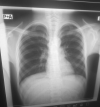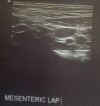Situs inversus with levocardia in a 15-year-old male adolescent: a case report
- PMID: 38042875
- PMCID: PMC10693697
- DOI: 10.1186/s13256-023-04254-9
Situs inversus with levocardia in a 15-year-old male adolescent: a case report
Abstract
Background: Situs inversus with levocardia is a rare anomaly in which the heart is present in the left chest but the abdominal viscera are transposed. It is caused by a single incomplete penetration of an autosomal recessive gene. It is unclear what exactly causes situs inversus with levocardia. Even if situs inversus can be identified following a comprehensive physical examination, it is now possible to validate the results and search for further information and pathologies since medical imaging is so widely accessible.
Case: A 15-year-old Oromo male child from a remote area of Bale Zone presented to the Goba Referral Hospital's medical emergency outpatient department complaining of periumbilical pain that had persisted for 4 months. He frequently came to our hospital and was admitted three times with the same problem. Objectively, there was tenderness over the left lower quadrant and periumbilical area. The sonographic evaluation discovered the transposition of the liver and spleen with cardiac apex on the left side. He received conservative treatment with ceftriaxone 1 g intravenous twice a day and metronidazole 500 mg intravenous for 5 days, and he went home improved.
Conclusion: Isolated levocardia is a rare form of situs inversus in which the heart is in the traditional levo position while the abdominal organs are in the dextro position. What causes situs inversus with levocardia is unknown. Despite the fact that situs inversus can be diagnosed after a thorough physical examination, medical imaging has allowed us to confirm the findings as well as understand more about diseases. Due to the severity of an underlying heart defect, situs inversus with levocardia has a dismal prognosis.
Keywords: Adolescent; Levocardia; Situs inversus; Situs inversus with levocardia.
© 2023. The Author(s).
Conflict of interest statement
We declare that there are no competing interests.
Figures





Similar articles
-
Isolated levocardia: two cases with abdominal situs inversus, thoracic situs solitus, and normal circulation.Am Heart J. 1983 Jul;106(1 Pt 1):155-9. doi: 10.1016/0002-8703(83)90456-8. Am Heart J. 1983. PMID: 6869182 No abstract available.
-
Situs inversus of the abdominal viscera with levocardia; report of eight cases submitted to the Blalock-Taussig operation.Circulation. 1951 Feb;3(2):202-14. doi: 10.1161/01.cir.3.2.202. Circulation. 1951. PMID: 14812648 No abstract available.
-
Clinics in diagnostic imaging (160). Levocardia with abdominal situs inversus.Singapore Med J. 2015 Apr;56(4):198-201; quiz 202. doi: 10.11622/smedj.2015059. Singapore Med J. 2015. PMID: 25917470 Free PMC article.
-
Prolonged survival with isolated levocardia and situs inversus.Cleve Clin J Med. 1991 May-Jun;58(3):243-7. doi: 10.3949/ccjm.58.3.243. Cleve Clin J Med. 1991. PMID: 1893555 Review.
-
Isolated levocardia: prenatal diagnosis, clinical importance, and literature review.J Ultrasound Med. 2007 Mar;26(3):361-5. doi: 10.7863/jum.2007.26.3.361. J Ultrasound Med. 2007. PMID: 17324986 Review.
Cited by
-
Incidental finding of levocardia with situs inversus: case report.Radiol Case Rep. 2024 Dec 17;20(3):1386-1388. doi: 10.1016/j.radcr.2024.11.042. eCollection 2025 Mar. Radiol Case Rep. 2024. PMID: 39801529 Free PMC article.
References
-
- Zilberstein B, et al. The treatment of portal hypertension by videolaparoscopy in situs inversus totalis. Hepatogastroenterology. 2000;47(33):678–680. - PubMed
-
- Taussig H. Congenital malforiiations of the heart. New York: The Commonwealth Fund; 1947.
Publication types
MeSH terms
LinkOut - more resources
Full Text Sources
Medical
Miscellaneous

